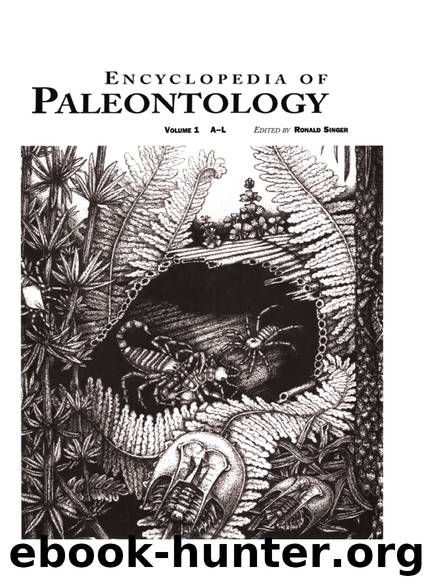Encyclopedia of Paleontology: A-L by Ronald Singer

Author:Ronald Singer [Singer, Ronald]
Language: eng
Format: epub
Tags: Science, Paleontology
ISBN: 9781884964961
Google: AKAhRgAACAAJ
Publisher: Fitzroy Dearborn
Published: 1999-01-15T20:28:05+00:00
DATING METHODS
Determining the numerical age in thousands or millions of years of rocks, fossils, and other geological features is essential to interpreting Earth history. There are several common ways of doing this.
Radiometric Techniques
Radioactive decay of an unstable element (usually called an âisotopeâ) begins when it becomes part of a mineral (crystallization) in a rock. The decay occurs at a geometric rateâthat is, over a given time interval the proportion of atomâs that decay to the number that remain stays the same, no matter how long the decay process continues. When half of the atomâs decay, we refer to this as one half-life. If we know the rate of decay and how much decay has taken place, then we can estimate how long the decay has been going on, in other words, the age of the mineral.
To determine this information, we need to know the âparentâ isotope and the âdaughterâ isotope. The unstable element in the decay process is called the parent isotope, and it changes to become a more stable isotope called the daughter. (The daughter isotope may also be radioactive.) In determining rock ages, the most common parent isotope studied is radioactive potassium (K40), which decays to its daughter, the noble gas argon (Ar40). One half-life in the K/Ar parent-daughter system is 1.25 billion years. Uranium-lead (U-Pb) and rubidium-strontium (Rb-Sr) are other parent-daughter isotope pairs widely used to determine the ages of rocks.
Carbon 14 (C14) is the unstable form of carbon produced in the upper atmosphere and then absorbed by living plants and animals. After an organism dies, the C14 in its body begins to decay to nitrogen 14 (N14), a process with a very short half-life: 5,730 years. Because of its short half-life, C14 dating generally is used only for objects no older than about 40,000 years. Organic matter older than that has so little C14 remaining that it is virtually impossible to detect. Therefore, C14 dating is applied almost exclusively to archeological problems, those that deal with human activities.
Using radioactive decay to determine the ages of rocks or fossils relies on a closed system to achieve accuracy. The parent isotope in the specimen must be only what was in the mineral when it crystallized originally, and the daughter isotope present must only be the product of radioactive decay of the parent. If any parent or daughter isotopes are incorporated in the specimen or removed from it, their proportions will not provide an accurate estimate of how much time has passed since the mineral crystallized originally. Breakdown of this closed system is the most obvious potential source of error in radiometric dating. Indeed, many minerals with radioactive elements have not remained stable enough to maintain the closed parent-daughter system, so they cannot give accurate age estimates. Furthermore, relatively few rocksâalmost exclusively those of igneous (volcanic) originâcontain enough radioactive material to be dated.
Radiation Damage Phenomena
Radioactive decay also can damage or alter minerals. If the rate and amount of this damage can be determined, then the duration of the process can be estimated.
Download
This site does not store any files on its server. We only index and link to content provided by other sites. Please contact the content providers to delete copyright contents if any and email us, we'll remove relevant links or contents immediately.
vogue knitting beginner basics by Unknown(1017)
280 Japanese Lace Stitches by Nihon Vogue(1004)
KNIT - Vogue Knitting on the go by Socks(901)
Knitting for Beginners: Learn How to Knit Quickly and Easily From Home (Knitting Books - Master this Amazing Craft and Knit Beautiful Patterns) by Victoria Lane(803)
The Pocket Guide to Fishing Knots: A Step-by-Step Guide to the Most Important Knots for Fresh and Salt Water - PDFDrive.com by Joseph B. Healy(641)
Ultimate Book of Everyday Knots by Geoffrey Budworth(549)
Crochet Collage Garden by Chris Norrington(533)
55 Fantastic Japanese Knitting Stitches by Kotomi Hayashi(516)
100 Crochet Tiles by Various(509)
The Ultimate All-Around Stitch Dictionary by Bernard Wendy;(493)
50 THINGS TO KNOW ABOUT KNITTING by Fanelli Christina(490)
Spooktacular Crochet by Annie's(474)
Better Homes & Gardens Can It! by Unknown(461)
Ultimate Illustrated Guide to Sewing Clothes by Mahon Joi;(453)
Traditional Knitting Patterns by James Norbury(438)
Cross Stitch Collection by Unknown(431)
First Time Embroidery and Cross-Stitch by Wyszynski Linda;(429)
Crochet Your Own Kawaii Animal Cuties by Katalin Galusz(428)
The Tunisian Crochet Handbook: A Beginnerâs Guide by Toni Lipsey(423)
